What size / shape / material for mid century skirting and architrave?
Hello,
We are renovating our mid century house, and nearly everything has been ripped out (there weren't any mid century features inside, but the bones of the house remain). We aren't going to be slaves to mid century specifically, but do like the style, and want to keep things modern looking.
The existing architraves and door frames are very fussy and painted in a high gloss white. The skirting was a dark tropical wood, which has been remove but we actually have retained in case it could be stripped and reused. It had a chamfered top, and a groove in it which seemed to collect dirt and dust.
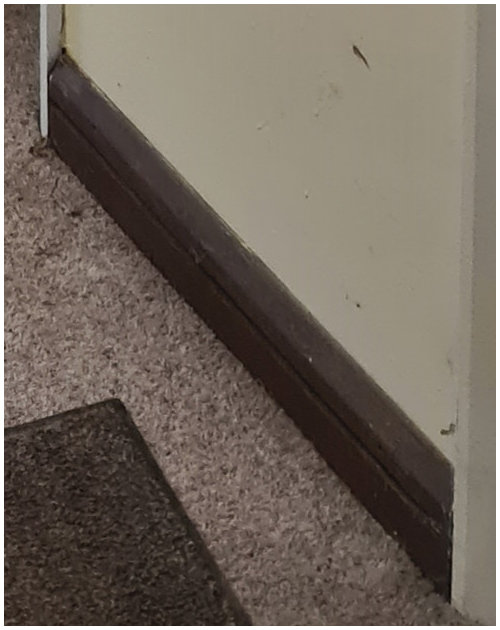
We are hoping to have oak parquet flooring throughout, and flush oak doors with matt black handles. This sort of this:
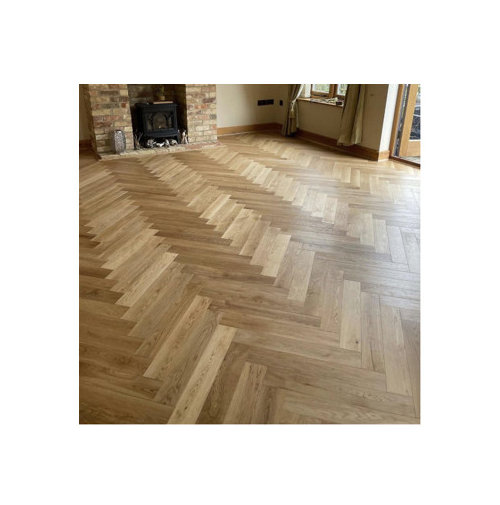

What architrave and skirting is a good fit for a MCM / modern house? We imagine oak (to match the doors and floors) would look good, but don't know what size or shape. We assume we need solid oak for durability - is that correct?
Would it be worth looking at retaining / reusing the original?
I do like a shadow gap, but the walls are all brick and we don't want the expense / complication as we are already over budget a lot.
Thanks very much :)
Comments (19)
Daisy England
last monthEven if you strip back the original skirting board and restain it you won’t get an oak finish. Stains change colour depending on what timber you’re adding them to. If you’re having oak herringbone flooring and oak doors then oak skirting and architrave is the way to go.
That skirting is similar to Torus and l say similar as it’s not exactly the same so l presume it has been bespoke made. A joiner can make it to make the design but it involves buying cutters to the shape of the pattern which are expensive to add in the machinery to produce it. Therefore I would find an alternative design that you like that is readily available.
Many joinery workshops have a range of cutters to produce various designs of skirting from a plank of oak so I would see who is local and ask them for a quote.Juliet Docherty
last monthI would replace with flat unfussy skirtings and architraves and paint them. I would also consider buying this book, it's very good. He talks about materials and references his own journey of painting his walls so many different colours before realising that white suited his pared down interiors. It's a really interesting read.

Heather N
Original Authorlast monthThanks very much. Why would you paint them, instead of just sticking with oak to match the doors and floors, out of interest? Is it to save budget, or so that they blend into the walls?
Jen
last monthTo my eyes, it looks best to have the same skirting and architraves throughout a house and painting them white or off-white will show off your floor, and be better suited to the architecture of a mid-century house.
Angie
last monthWe’re working our way through our house (which is Edwardian, so not mid-century) replacing skirtings, architraves, doors and door linings with oak, and it looks fabulous. The oak is treated with Osmo and looks stunning. Our skirting is not dissimilar to the one in your photo, but ours has two grooves. They’ll probably gather dust, but I have a nifty gadget to clean them so not too much of a concern.
Daisy England
last monthI wouldn’t paint them. Once you have oak and apply a coat of finish it’s long lasting and hardly needs reapplying so keeps maintenance down. Look at Monocoat for your finish. That’s what we use as a company for our timber products.
Sonia
last monthI would think mid century would have simpler, plainer skirting and architrave? I do think choosing oak or painting them is personal taste. Some people like oak everywhere, whether it’s flooring, skirting, architrave and doors and windows. For me that’s wood overload so I personally would have white painted architrave and skirting and maybe keep the doors and floor natural oak. But that’s just me and you should have what you love. All skirting gets dusty so a quick dust every week or so will keep it nice and clean. First pic is what I would do, and I might even paint the door! Second pic is natural oak door, architrave and skirting. Neither is right or wrong.


Isla Cherry
last monthI agree with the plainer skirting, get a bull nose so its easier to dust and then paint it all white. I have oak doors and the architraves and skirtings are white. It frames the oak much better than the outline style of oak architraves and skirting. Agree with macbroom hate the look of oak skirting & architrave climbing up the wall.
Angie
last monthIf you decide on painted skirtings, I wouldn’t buy oak. It’s too expensive to go covering in paint! It’s all a case of personal taste at the end of the day. So glad we’ve gone with oak, we think it looks stunning in our house.
Isla Cherry
last monthFor painted skirtings MDF is the best material as it is stable and doesn't warp. Once it is painted you won't know the difference. I certainly wouldn't paint oak.
Heather N
Original Authorlast monthThanks so much everyone. I was drawn to the simple oak framing the flush door as I'd seen it in a mid century house that was for sale. I wonder if there's something about the door being flush with no detailing that makes the simple oak framing the door work nicely, but I'm not an interior designer!
Here was the one we saw, a really interesting profile, doubt we could find off the shelf and don't want the cost of bespoke. Weird they have the white gloss door lining though!
I have bad memories of white gloss paint!
Budget may dictate we need to go with MDF, but I might shoot for oak and see where the budget lands
Does anyone have advice on how to figure out how big the skirting should be, and what shape? We're definitely hoping to get something unfussy but I've got no experience in this sort of detailing. Curved top? Angled edge?

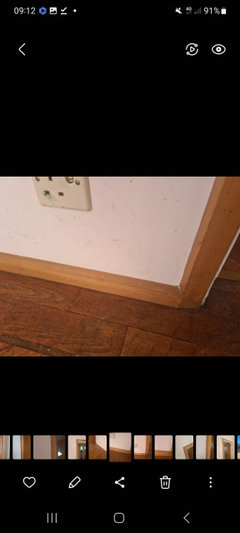


Heather N
Original Authorlast monthHere are a few I've found. I've no idea how to choose between them, and then what size to go for! Any advice very very appreciated, thank you.



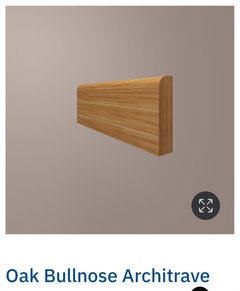


Sarah L
last monthWell I live in a 1960s bungalow that still has the original skirting and architrave in some rooms. It's a simle white painted pine chamfered style. I'm replacing them room by room with a simple white painted mdf bullnose style. I recommend loveskirting.co.uk for oak trims I've used elsewhere.
Isla Cherry
last monthI've had pine skirtings and they warp over time. The gap between the wall and the top of the skirting gets larger and larger. MDF with a bullnose is the easiest option.
rinked
last monthEither oak to match floors and doors, or plain offwhite (mdf seems cheapest these days).
My home is 1950s and we kept as much of the original as possible, simple rounded ones. We sanded down the original pine plank floors and then placed pine skirting, as the original floor had to come out to insulate underneath.
Angie
last monthWe got our skirting boards from here, https://www.skirting4u.co.uk/ and they do free samples. The samples were in mdf, but show the size and profile nicely. We had several samples from which we chose what we wanted. We’ve been very happy with the quality of the skirtings we’ve had from them, and the architraves. We’ve now done three rooms plus a small landing, and four doorways.
SPEAK
last monthHi Heather,
Thank you for sharing your project, particularly love your choice of flooring, it will look beautiful.
A few further design pointers for you:
Starting Point:Select your doors and hardware first, then search for skirting which might have a feature you can pull out to compliment the doors and hardware, see image below from UK Howdens – see the stepping effect on the skirting board replicated within the door trim? (these are the types of small but effective details interior designers look out for)
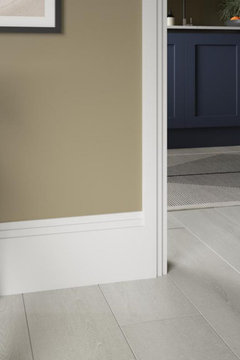
Painting Oak:As suggested by the Houzz community – we also would avoid overpainting Oak, it is an expensive material and is designed to showcase its own natural beauty without the need for a painted coating.
Flooring Selection:The beautiful flooring you have already selected will be the main focal point throughout – especially the herringbone pattern and natural graining in the wood, framing your door with a similar wood might cause a boxed in effect within the spaces. If you are looking to achieve a framing effect this could easily be done within the flooring – see border image within flooring below:
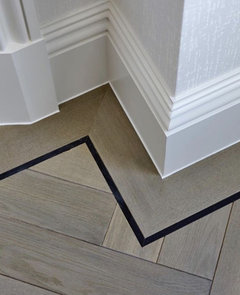
Door Handles:Door handles are a very clever way to extend your interior design style theme – down to the finest details you have accurately already captured the mid-century modern feel with your chosen selection of matt black, think about the shape you are opting for in addition.
Skirting Sizes:- In terms of sizes: it would be at your personal discression, it also worth noting that the current size is encased in a colour that does not showcase the grooved design. The average height for skirting boards throughout the UK is 145mm (approximately 6 inches). When it comes to choosing the height for your skirting, it comes down to personal preference. We have found that our most popular sizes range from 120mm (approximately 5 inches) up to 220mm (approximately 9 inches). Start by measuring your current skirting and mark out the difference between what is currently there and the size of designs you like. The image below features the higher version with similar flooring you have selected.
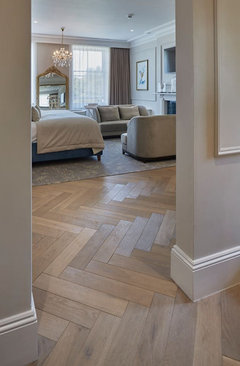
Opting for plain white skirting to showcase your flooring, doors and any additional accessories you plan on implementing would be our best guidance, simplicity is key when it comes to skirting boards.
Please keep us posted with your project outcomes.
Warm and best wishes
Team SPEAK

Reload the page to not see this specific ad anymore
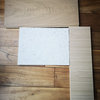


macbroom